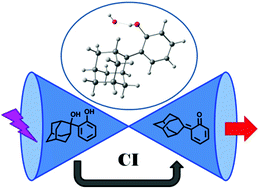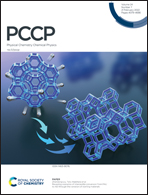Photogeneration of quinone methide from adamantylphenol in an ultrafast non-adiabatic dehydration reaction†
Abstract
The ultrafast photochemical reaction of quinone methide (QM) formation from adamantylphenol was monitored in real time using femtosecond transient absorption spectroscopy and fluorescence upconversion in solution at room temperature. Experiments were complemented by theoretical studies simulating the reaction pathway and elucidating its mechanism. Excitation with sub-20 fs UV pulses and broadband probing revealed ultrafast formation of the long-lived QM intermediate directly in the ground state, occurring with a time constant of around 100 fs. UV-vis transient absorption data covering temporal dynamics from femtoseconds to hundreds of milliseconds revealed persistence of the absorption band assigned to QM and partially overlapped with other contributions tentatively assigned to triplet excited states of the adamantyl derivative and the phenoxyl radical that are clearly distinguished by their evolution on different time scales. Our data, together with the computations, provide evidence of a non-adiabatic photodehydration reaction, which leads to the formation of QM in the ground state via a conical intersection, circumventing the generation of a transient QM excited state.



 Please wait while we load your content...
Please wait while we load your content...